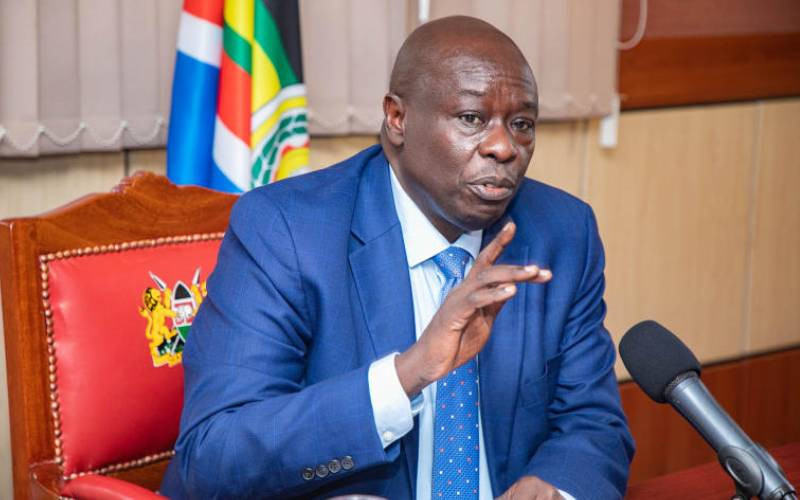By Muchiri Waititu
A recent occurrence in Eastleigh in Nairobi made me quite amused the other day.
A gentleman who had recently purchased a commercial plot had gone ahead to commence the erection of a boundary wall only to be arrested by City Council askaris.
He must have had a ‘silver tongue’ because he was released two hours later only for him to get a friendly visit from the Ministry of Labour and Nema. They issued notices to him to stop construction. Failure to stop “immediately henceforth” (I wonder where all bureaucrats get this language) would lead to unexplained consequences in accordance to the Environmental Management and Coordination Act as well as the Factories Act.
In desperation, the harassed man sought the services of a professional who took him through the hurdles he was required to overcome in order to attain his dream of being a landlord.
He is still trying to get his refund from the person who sold him the plot.
Before I explain the steps one needs to take before getting a building permit (and what the Eastleigh gentleman was advised), let me explain how things work in a neighbouring East African country.
Sometimes, in order to understand a problem, one needs to comprehend the opposite. To understand darkness, one needs to see the light.
In that country, there is a government body, which houses the equivalent of our National Environment Management Authority, Kenya Revenue Authority, Registrar of Companies, City Council, Ministry of Lands and Ministry of Planning among others; a one-stop shop inter departmental agency, which makes no fuss about its service delivery capabilities.
Prompt service
Registration of a new company is accomplished in two days flat, tax registration in an hour, and a building permit is ready in two weeks (if they have not reverted in two weeks, then the project is deemed “approved” by default).
Yours truly was pleasantly surprised when he received a call originating from the country’s agency inquiring why I had a perimeter wall with electric fencing in my project yet this was not allowed. Sensing my consternation, he explained that this was unnecessary since there was remote possibility of someone trying to jump into the project and anyway, they were very unpleasant aesthetically.
To help me out, so that my documentation met his discerning standards, he went ahead and sent me a master plan for the entire capital city as well as precise guidelines covering everything from architectural features to environmental initiative.
In case you may not have guessed by now, this country is Rwanda. The city council of Kigali has master planned the entire city to allow for development and so long as an individual project is able to illustrate that it meets criteria outlined in the master plan in terms of character, height, material usage, accessibility and is environmentally sensitive, then approval follows without any fuss.
Further, the whole city has been digitally mapped with ownership data lumped together with utility connections all available on demand online.
Stay informed. Subscribe to our newsletter
This means that you can conduct a search on the ownership status, find out the development status of the property (is there a household on the property, what type of house is it?), when was the development undertaken, who was the architect, is there a power connection to the property, is there a water connection (is it paid to date?), how far is the nearest manhole to connect your sewer? All questions answered from the comfort of your computer.
Back to the country and my original objective to explain how things work in Kenya, Let’s become KRA’s latest tax evader and musician Mejja’s most hated figure; Bwana Landlord.
Convoluted processes
First, of course after making your sale proposal to the plot owner, you will contact your lawyer who has to undertake a “due diligence” to establish the registered owner.
This is done via a “search” at the Ministry of Lands whose outcome is a document declaring who the registered owner is. A further search at the City Council usually matches the registered rate payer with the registered owner and a sale agreement drawn up with the eventual exchange of legal tender taking place to close the deal. This process on average takes a month or so unless you have a silver tongue.
Secondly, the purchaser at this point is not clear on the “use” of the property as he will usually base his decision on other neighbouring developments. If my neighbour has developed a block of flats, then getting approval for my ‘Muwa Plaza’ (Muchiri Waititu; we Kenyans love to mash up our names), should be a simple matter.
Use decrees
Not so. Clause five in the Title usually stipulates what you can do with the property. If it says ‘commercial purposes’, then you will have to undertake a ‘change of user’, a process involving a registered planner, the City Council and putting paid up adverts in the local dailies. Another month if you are lucky.
Then you will walk to my fellow professional who will design your dream apartments. These will then be submitted to the City Council (again!) for approval with the structural designs being submitted (again to the City Council!) by a registered engineer. The process should take about three months.
We are not yet done. At this point, you have to submit the drawings to Nema who confirm that indeed the apartments are right next to other apartments and give you approval to build (approval is issued in 40 days by law).
The whole gestation period for a project takes the same time and has the same labour as the gestation period of a human being. As to why we are giving so much pain to people creating wealth, I don’t know.
What I know is this. The entire land registry, building approval process should be made easy by combining all these overlapping bureaucracies. Put all of them under one roof.
I hope someone at Vision 2030 is listening. It is the only body with the capacity to do this in one move. No learning curve required.
The writer is an architect in private practice as well as being a vice-chairman, Architectural Association of Kenya, construction Project Management chapter.
 The Standard Group Plc is a
multi-media organization with investments in media platforms spanning newspaper
print operations, television, radio broadcasting, digital and online services. The
Standard Group is recognized as a leading multi-media house in Kenya with a key
influence in matters of national and international interest.
The Standard Group Plc is a
multi-media organization with investments in media platforms spanning newspaper
print operations, television, radio broadcasting, digital and online services. The
Standard Group is recognized as a leading multi-media house in Kenya with a key
influence in matters of national and international interest.
 The Standard Group Plc is a
multi-media organization with investments in media platforms spanning newspaper
print operations, television, radio broadcasting, digital and online services. The
Standard Group is recognized as a leading multi-media house in Kenya with a key
influence in matters of national and international interest.
The Standard Group Plc is a
multi-media organization with investments in media platforms spanning newspaper
print operations, television, radio broadcasting, digital and online services. The
Standard Group is recognized as a leading multi-media house in Kenya with a key
influence in matters of national and international interest.









